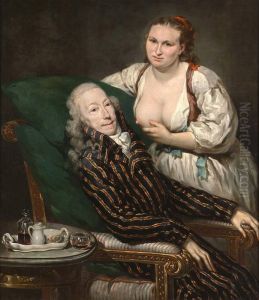Barbara Krafft Paintings
Barbara Krafft, born Barbara Steiner, was an Austrian painter known for her portraits, born on April 1, 1764, in Jihlava (Iglau), in what is now the Czech Republic. She was a prominent figure in the artistic circles of her time, particularly noted for her adeptness in capturing the likeness and character of her subjects. Krafft's work represents the transition from the late Baroque to the early Romantic periods in European art, and she was particularly influenced by the neoclassical style.
Her early life was marked by a passion for art, and she received her initial training from her father, Johann Baptist Steiner, a relatively unknown painter. Despite the limitations placed on female artists during the 18th and early 19th centuries, Krafft pursued her artistic career with determination. She moved to Vienna with her husband, Johann Baptist Krafft, a minor painter and musician, where she became actively involved in the city's artistic life. After her husband's death in 1795, Barbara Krafft moved to Salzburg, where she established herself as a sought-after portraitist.
Krafft's most famous work is undoubtedly the posthumous portrait of Wolfgang Amadeus Mozart, painted in 1819, which has become one of the most iconic and widely recognized images of the composer. Despite never having met Mozart, Krafft's portrait was based on earlier images and captures the essence of Mozart's genius, contributing significantly to the visual legacy of the composer. Throughout her career, Krafft painted numerous portraits of prominent figures of her time, including members of the aristocracy, clergy, and bourgeoisie, as well as family portraits that were highly regarded for their sensitivity and depth.
Barbara Krafft's contributions to art were recognized during her lifetime, and she enjoyed a successful career. Her works are characterized by their emotional depth, detailed realism, and the subtle use of color and light, which have contributed to her lasting reputation. Krafft continued to work and receive commissions until her death on September 28, 1825, in Salzburg. Today, her paintings are held in various art collections and museums, where they continue to be appreciated for their historical significance and artistic merit.




